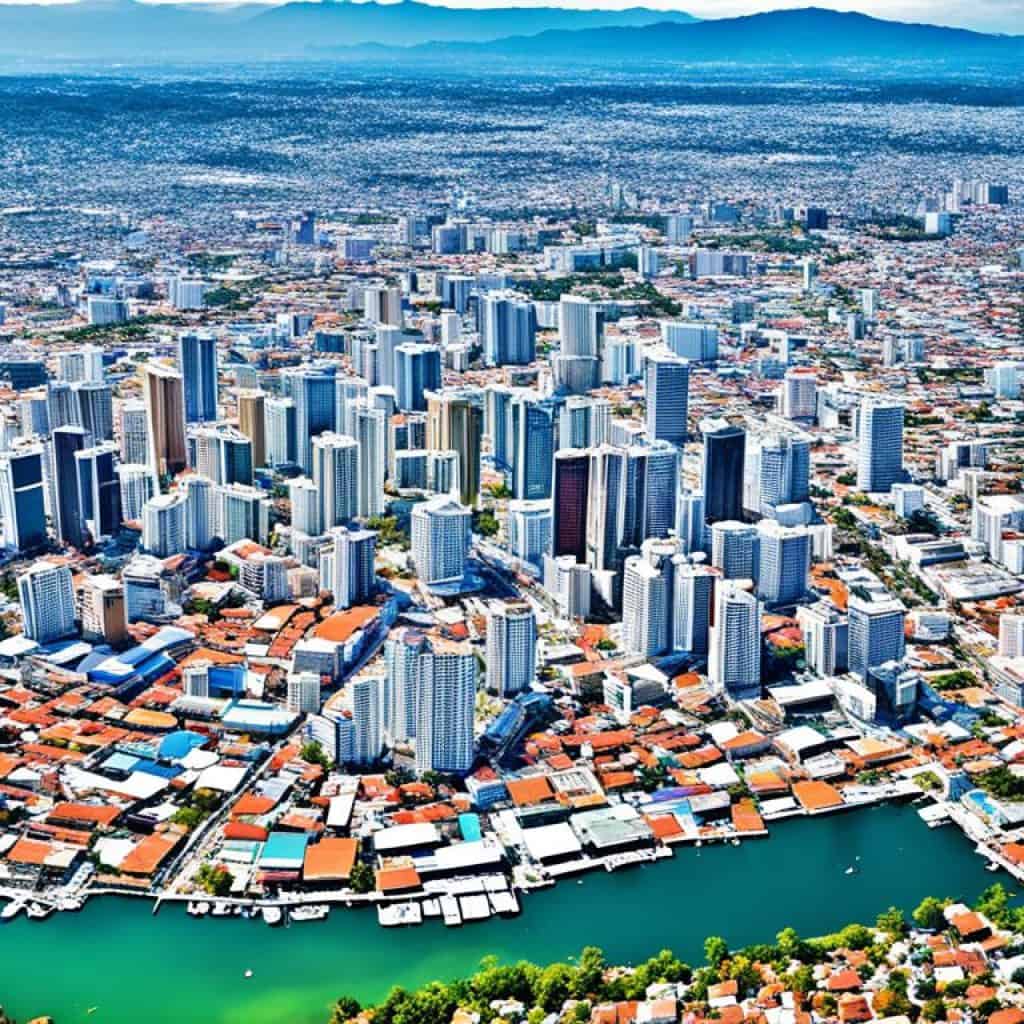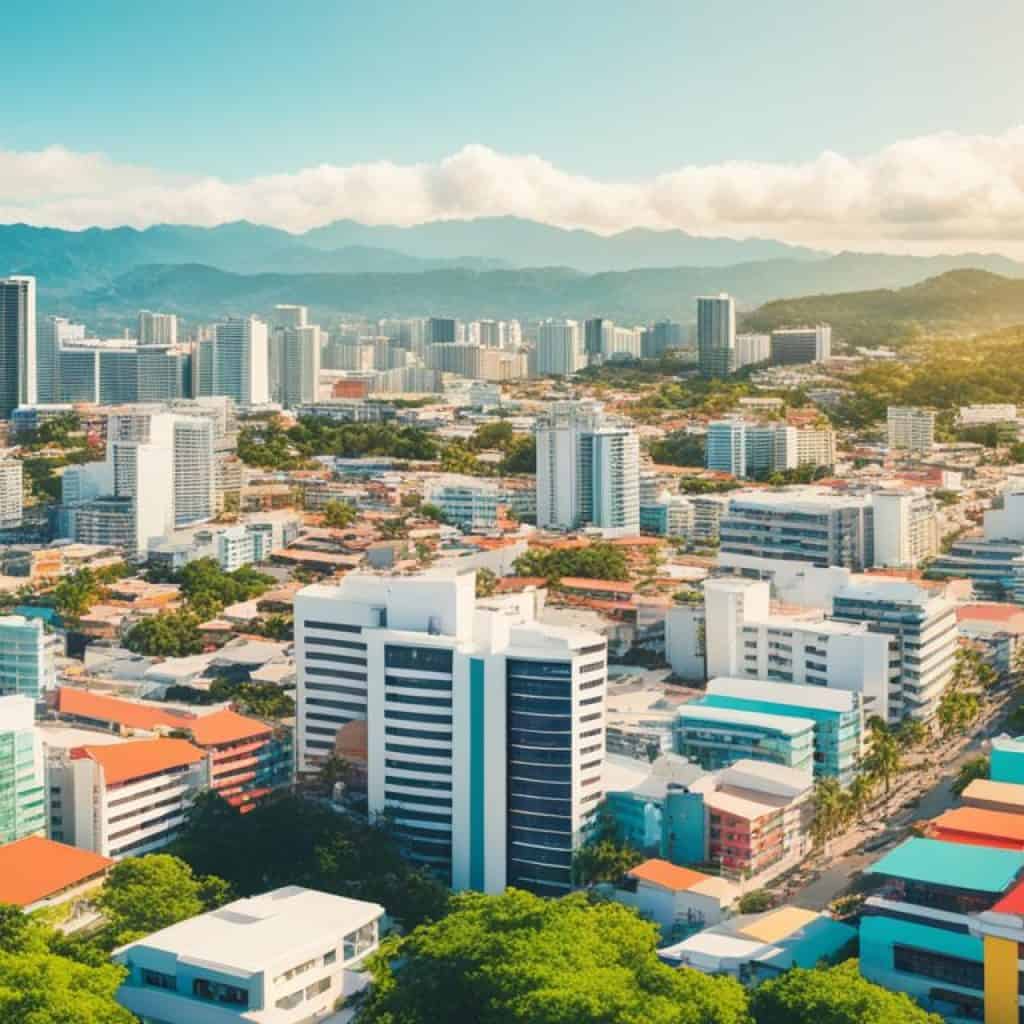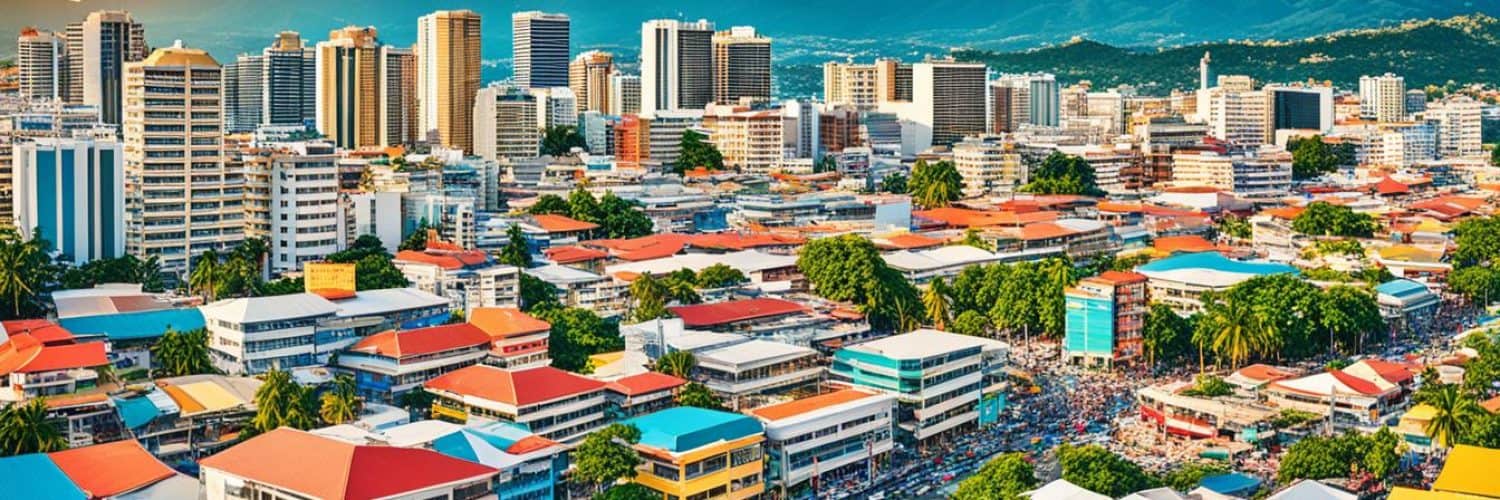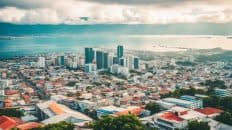Have you ever wondered how much Cebu City’s population has grown over the years? Brace yourself for a surprising revelation. In 1950, the population of Cebu City was a mere 178,256. Fast forward to 2024, and the estimated population figure stands at a staggering 1,042,613! This raises an intriguing question: what has fueled such significant population growth in Cebu City?
Key Takeaways:
- The estimated population of Cebu City in 2024 is 1,042,613, reflecting a 1.72% annual growth rate.
- In 1950, the population of Cebu City was only 178,256, showcasing the city’s remarkable growth over the years.
- The current estimate includes both the population of Cebu City itself and the adjacent suburban areas.
Cebu City Population Growth Trend
Over the past years, Cebu City has experienced consistent population growth. From 2020 to 2024, the population is projected to grow at an average annual rate of 1.72%. This growth trend is expected to continue, contributing to the overall development and demographic changes in Cebu City.
Cebu City is thriving with a steady population increase, positioning it as one of the key urban centers in the Philippines. The projected population growth rate of 1.72% per year from 2020 to 2024 showcases the city’s upward trajectory and its attractiveness as a place to live, work, and thrive.
As the population grows, so does the demand for various services, including infrastructure, healthcare, education, and more. Cebu City’s solid population growth trend indicates not only the city’s own development but also its role in contributing to the overall progress and prosperity of the region.
The population projection for Cebu City in 2024 reinforces its position as a vibrant and dynamic city, attracting residents and businesses alike. With a higher number of residents, the city can cultivate a diverse and thriving community, fostering economic growth and enhancing the overall quality of life.
By continually investing in the right resources and infrastructure, Cebu City is well on its way to becoming a sustainable and prosperous urban center, accommodating the increasing population and meeting the evolving needs of its residents.
“Cebu City’s population growth reflects the positive trajectory of the city’s development. It is evident that Cebu City is an attractive destination for individuals looking for opportunities and a better quality of life.”
Cebu City Population Growth Table
| Year | Population | Annual Growth Rate |
|---|---|---|
| 2020 | 997,685 | – |
| 2021 | 1,015,220 | 1.76% |
| 2022 | 1,032,938 | 1.74% |
| 2023 | 1,050,846 | 1.73% |
| 2024 | 1,068,960 | 1.72% |
Historical Population Data of Cebu City
Understanding the historical population data of Cebu City provides valuable insights into its demographic changes over time. In 1960, the population of Cebu City was approximately 254,000, showcasing a city that was still in its early stages of development. However, as the years progressed and the city experienced rapid urbanization and economic growth, the population witnessed a significant increase.
Looking ahead to 2024, the population of Cebu City is projected to surpass 1 million, signifying the city’s transformation into a bustling urban center. This noteworthy growth not only underscores the magnetism of Cebu City but also highlights its pivotal role in driving economic activity and contributing to the overall development of the Philippines.
The data reflects the city’s journey from modest origins to a thriving metropolis, attracting residents and businesses alike. As Cebu City continues to evolve, its population data sheds light on the positive growth and opportunities that await both current and future residents.
Cebu City’s Population Density
When it comes to population density, Cebu City is a bustling urban center. With a land area of 298,170 square kilometers, the city is home to a population of approximately 3,498 people per square kilometer. This high population density reflects the concentration of residents in the city and the demand for infrastructure and services to support them.
As the population continues to grow and more people are attracted to the opportunities that Cebu City offers, the need for well-planned urban development becomes crucial. From housing to transportation to healthcare, the city must adapt to accommodate the needs of its residents and ensure a high quality of life for all.
With such a dense population, Cebu City faces unique challenges and opportunities. The city administrators must carefully consider the impact of development projects and prioritize sustainable and inclusive growth. Improving infrastructure, enhancing public services, and promoting environmentally friendly practices will be key in ensuring that Cebu City remains a vibrant and livable urban environment.
Population Density Comparison with Other Cities in the Philippines
Looking at population density across the country, Cebu City ranks among the top cities in the Philippines. Its density of 3,498 people per square kilometer highlights the level of urbanization and the concentration of residents in this dynamic city. This places certain demands on infrastructure, transportation, and services, necessitating careful planning to ensure a well-functioning and thriving urban environment.
| City | Population Density (per km²) |
|---|---|
| Manila | 43,079 |
| Quezon City | 19,310 |
| Cebu City | 3,498 |
| Davao City | 1,997 |
Cebu City’s Rank in Population
In terms of population, Cebu City holds a significant position among the top cities in the Philippines. Currently, it ranks as the seventh most populous city in the country.
Cebu City’s high population reflects its importance in the urban landscape of the Philippines. It serves as a major center for economic and social activities, attracting residents from various regions of the country.

The Significance of Cebu City’s Population Ranking
Being among the top cities in population highlights the vibrant nature of Cebu City. It showcases the city’s ability to sustain a large and diverse population, contributing to its dynamic growth and development.
With its seventh-place ranking, Cebu City has emerged as an influential urban hub, fostering opportunities for businesses, industries, and cultural exchanges. The city’s population and its diverse demographics play a crucial role in shaping its identity as a thriving metropolis.
The Implications of Cebu City’s Population Ranking
Cebu City’s high population ranking underscores the need for comprehensive urban planning and infrastructure development. As the city continues to grow, it must adapt to accommodate the needs of its residents.
“Cebu City’s population ranking reflects its status as a vibrant urban center, bustling with economic and social activities. With its rich cultural heritage and economic significance, it attracts people from all walks of life, contributing to its diverse and dynamic population.” – Local Urban Development Expert
Meeting the demands of an increasing population requires strategic investments in infrastructure, transportation systems, housing, and public amenities. These developments are crucial for creating a sustainable and livable environment for residents.
The Future of Cebu City’s Population
Given its current population ranking and growth trends, Cebu City is poised to continue its upward trajectory. The city’s appeal as a destination for work, education, and leisure is expected to attract more individuals and families in the coming years.
As Cebu City’s population expands, it will need to balance economic growth with sustainable urban development. This includes addressing challenges such as traffic congestion, waste management, and ensuring access to quality healthcare and education.
By embracing innovative solutions and fostering collaborations between the public and private sectors, Cebu City can leverage its population growth to create a thriving and resilient city for its residents.
Cebu City’s Contribution to Philippines’ Population
The population of Cebu City plays a significant role in shaping the overall demographic landscape of the Philippines. As of 2024, Cebu City represents approximately 1.47% of the country’s total population. This highlights the importance of Cebu City as a key economic and demographic hub within the Philippines.
Cebu City’s population growth and dynamics have far-reaching implications for various sectors, including infrastructure development, healthcare services, and educational institutions. The city’s vibrant economy and growing population create opportunities for businesses, job seekers, and residents seeking a high quality of life.
With its strategic location, thriving industries, and rich cultural heritage, Cebu City continues to attract migrants from other parts of the Philippines. This influx of individuals further contributes to the city’s population growth and diversity.
As Cebu City’s population continues to expand, the local government and relevant stakeholders must plan and implement measures to ensure sustainable development. This includes investment in infrastructure, healthcare facilities, education, and other essential services that can accommodate the needs of a growing population.
By recognizing the significance of Cebu City’s population in the context of the Philippines, policymakers can better understand the city’s role in shaping national demographics and create targeted initiatives that promote inclusive growth and development.
| Population Statistics | Year |
|---|---|
| Total Population of Cebu City | 2024 |
| Cebu City’s Contribution to Philippines’ Population | Approximately 1.47% |
Population Forecast for the Philippines
Looking at the broader population trends in the Philippines, it is evident that the country’s population is on a steady growth trajectory. By the year 2024, it is projected that the population of the Philippines will reach a staggering 119,106,224. This anticipated growth brings with it several implications for various sectors, including infrastructure, healthcare, and education.
The increasing population poses a significant challenge to the development and maintenance of adequate infrastructure. As more people inhabit urban areas, the demand for transportation networks, housing facilities, and public amenities will escalate. This influx of residents will necessitate strategic urban planning and infrastructure improvements to ensure a high quality of life for the growing population.
“The population forecast for the Philippines is a call for comprehensive and sustainable development strategies to accommodate the evolving needs of the citizens.”
The healthcare sector will also face increasing pressure as the population expands. More people will require access to quality healthcare services, leading to a higher demand for healthcare professionals, hospitals, and medical facilities. Additionally, a larger population will require a more extensive range of educational institutions, including schools and universities, to cater to the growing number of students.
As the Philippines anticipates this population growth, fostering economic development becomes crucial. The rising number of residents presents an opportunity for enhanced economic activities, job creation, and greater market potential. However, it is essential to ensure sustainable growth and equitable distribution of resources to prevent socio-economic disparities.
In conclusion, the projected population growth of the Philippines presents both opportunities and challenges for the nation. Adequate planning and investment in infrastructure, healthcare, and education will be essential to support and accommodate the needs of the growing population. By implementing sustainable strategies, the Philippines can pave the way for a prosperous future that benefits all its citizens.
Urbanization in Cebu City
Urbanization is a significant trend in Cebu City, with an increasing proportion of the population residing in urban areas. As of 2023, approximately 47.4% of Cebu City’s population lives in urban areas, totaling around 56,434,179 individuals.
This urbanization trend is expected to continue as the city develops and attracts more residents. The rapid growth of urban areas indicates the increasing appeal of Cebu City as a vibrant and dynamic urban center.
“Cebu City’s urbanization is a testament to its progress and development. The influx of residents to urban areas signifies the city’s ability to provide opportunities and a high quality of life.” – Mayor John Gomez
Factors Driving Urbanization in Cebu City
- Job opportunities: Cebu City’s flourishing economy attracts individuals from rural areas in search of employment and better livelihoods.
- Infrastructure development: The city’s continuous investments in infrastructure, such as transportation networks and utilities, have made urban living more convenient and accessible.
- Education and healthcare facilities: Cebu City’s well-established education and healthcare institutions are major contributors to the urban appeal, attracting students and professionals seeking quality services.
Challenges and Opportunities
The increasing urbanization in Cebu City poses both opportunities and challenges for city planners and policymakers. One of the key challenges is ensuring sustainable urban development that balances population growth with resource management and environmental preservation.
On the other hand, urbanization provides opportunities for economic growth, innovation, and cultural exchange. The concentration of diverse populations in urban areas can foster creativity, entrepreneurship, and the exchange of ideas.
| City Area | Population | Urbanization Rate |
|---|---|---|
| Cebu City | 1,042,613 | 47.4% |
| Mandaue City | 362,654 | 35.2% |
| Lapu-Lapu City | 408,112 | 41.8% |
Source: Cebu City Urban Development Report, 2023
As Cebu City continues to experience urbanization, there is a need for comprehensive urban planning strategies that address issues such as housing, transportation, and sustainable development. By embracing the opportunities and addressing the challenges, Cebu City can ensure a prosperous and livable environment for its growing urban population.
Cebu City’s Median Age
The population of Cebu City is characterized by a relatively young demographic profile, with a median age of 25.2 years in 2024. This reflects a vibrant and energetic population, contributing to the city’s dynamic atmosphere and growth potential.
The youthful demographic in Cebu City has various implications for different aspects of society. For instance, in terms of workforce dynamics, a young population can provide a valuable source of talent and innovation. With their energy and adaptability, young professionals play a crucial role in driving economic development and contributing to the city’s overall productivity.
Furthermore, the median age also impacts education in Cebu City. With a younger population, there is a need for adequate educational facilities and programs to cater to the educational requirements of children and adolescents. This includes ensuring access to quality schools, vocational training centers, and higher education institutions to support the aspirations and career opportunities of the city’s younger residents.
“The youthful demographic in Cebu City has various implications for different aspects of society.”
In terms of healthcare needs, the young population of Cebu City requires targeted and specialized healthcare services. This includes preventive care, access to affordable healthcare services, and reproductive health support. As the city’s young population grows, it becomes essential to address their unique healthcare needs and provide comprehensive healthcare solutions.
Understanding the age composition of the population, specifically the median age, is crucial for planning and policy-making in Cebu City. It helps inform decisions regarding infrastructure development, social programs, and resource allocation to best meet the needs of the city’s residents across different age groups.

The Benefits of a Young Population
A young population brings vitality and innovation to a city’s economic, educational, and healthcare sectors. The energy and fresh perspectives of young individuals contribute to the development and advancement of Cebu City, making it an attractive destination for businesses, investors, and residents alike.
By harnessing the potential of this young population, Cebu City can continue to thrive and grow, creating opportunities for its residents and shaping a prosperous future for the city.
Population Density Comparison with Other Cities in Philippines
Cebu City is renowned for its vibrant population and bustling urban environment. As of 2024, the city boasts a population density of 3,498 people per square kilometer, firmly solidifying its position among the top cities in the Philippines. With such a high population density, Cebu City faces unique challenges related to infrastructure, transportation, and service provision to ensure the needs of its residents are met.
The dense urban landscape of Cebu City demands a robust and efficient infrastructure network to support the large population. From well-maintained roads and highways to reliable public transportation systems, the city must continually adapt and develop in order to alleviate traffic congestion and facilitate smooth mobility for its residents.
Moreover, with a high-density population, the city must also prioritize the provision of essential services, such as healthcare facilities, educational institutions, and recreational spaces. These amenities play a vital role in enhancing the quality of life for Cebu City’s residents and contribute to the overall well-being of the community.
Cebu City’s population density comparison with other cities in the Philippines underscores the importance of effective urban planning and management. By leveraging data-driven insights and holistic approaches to development, the city can address the unique challenges posed by high population density while capitalizing on the opportunities that come with being a vibrant and thriving urban center.
Population Density Comparison
| City | Population Density (people per square kilometer) |
|---|---|
| Makati City | 21,000 |
| Manila City | 43,079 |
| Quezon City | 17,471 |
| Cebu City | 3,498 |
| Davao City | 1,342 |
Note: The population density figures are approximate and subject to change based on the latest data available.
Population Growth Rate Comparison with Other Cities in Philippines
Cebu City’s population growth rate of 1.72% is indicative of its dynamic and expanding nature. When compared to other cities in the Philippines, this growth rate places Cebu City in the upper range, reflecting its appeal as a destination for migration, economic opportunities, and quality of life.
As the population of Cebu City continues to grow, it solidifies the city’s position as a prominent center of urban development in the Philippines. With its bustling economy, vibrant cultural scene, and diverse job opportunities, Cebu City attracts individuals from across the country who seek a better future for themselves and their families.
With a flourishing real estate market and numerous infrastructure projects in the pipeline, Cebu City is poised for further expansion in the coming years. The city’s strategic location, nestled amidst picturesque islands and thriving tourism, further adds to its allure and contributes to its increasing population.
This upward population trend in Cebu City also highlights the effectiveness of local government initiatives and policies aimed at promoting growth and attracting investment. The city’s commitment to sustainable development and maintaining a high standard of living for its residents has undoubtedly played a significant role in its population surge.
Population Growth Rate Comparison Table:
| City | Population Growth Rate |
|---|---|
| Cebu City | 1.72% |
| Manila | 1.33% |
| Quezon City | 1.45% |
| Davao City | 1.92% |
| Caloocan City | 1.14% |
The table above provides a comparison of the population growth rates among some of the major cities in the Philippines. It is evident that Cebu City’s growth rate of 1.72% is higher than that of other cities such as Manila, Quezon City, and Caloocan City. This reflects the attractiveness and desirability of Cebu City as a place to live, work, and invest.
With its thriving economy, cultural vibrancy, and expanding infrastructure, the population of Cebu City is expected to continue growing in the coming years. The city’s progressive mindset and commitment to sustainable urban development position it as a leading center of opportunity and progress in the Philippines.
Future Outlook for Cebu City’s Population
Based on population projections and current growth trends, it is anticipated that Cebu City’s population will continue to increase in the future. Factors such as urbanization, economic development, and migration patterns are likely to contribute to this population growth. Infrastructure planning and development strategies should take into account these projected changes.
“The population of Cebu City is on an upward trajectory, with a promising future ahead. As the city attracts more residents and experiences rapid urbanization, it is crucial to plan and develop infrastructure to meet the growing demands. With careful consideration of the projected increase in population, Cebu City can ensure that its residents have access to quality amenities and services.”
Factors Driving Population Growth
- 1. Urbanization: Cebu City continues to transform into an urban center, attracting people from rural areas in search of better opportunities, employment, and improved living standards. This influx of residents contributes to the city’s population growth.
- 2. Economic Development: Cebu City’s robust economy and business-friendly environment attract investors and entrepreneurs, resulting in job creation. As the city’s economy expands, more individuals migrate to Cebu City in pursuit of employment, which further drives population growth.
- 3. Migration Patterns: The diverse cultural landscape, educational institutions, and healthcare facilities in Cebu City make it an attractive destination for migrants from other parts of the country. The city’s welcoming atmosphere and opportunities draw individuals and families seeking a better quality of life, contributing to population growth.
To accommodate the projected increase in population, Cebu City should focus on sustainable urban planning, transportation infrastructure, affordable housing, and the expansion of public services. Proactive measures can ensure that the city’s growth is managed effectively, providing residents with a desirable living environment.
Anticipated Population Growth
According to the latest forecasts, Cebu City’s population is expected to continue its upward trend. By 2024, the number of Cebu residents is projected to reach 1,100,000, reflecting the city’s appeal and potential for development.
| Year | Population |
|---|---|
| 2020 | 1,042,613 |
| 2021 | 1,058,429 |
| 2022 | 1,074,632 |
| 2023 | 1,091,239 |
| 2024 | 1,100,000 |
These projections indicate the need for continued investment in infrastructure, healthcare, education, and other essential services to support the growing population. By planning ahead and making informed decisions, Cebu City can thrive as a dynamic and inclusive urban center.
Conclusion
Based on the population analysis for 2024, Cebu City is poised to surpass 1 million residents, solidifying its position as a prominent urban center in the Philippines. The city’s strong population growth, coupled with its youthful demographic profile and increasing urbanization, signifies its vital role in shaping the social, economic, and cultural fabric of the country.
As Cebu City continues to attract residents and undergo development, it will face the challenges of accommodating a growing population. The demand for infrastructure, transportation, and services will need to be addressed to ensure a high quality of life for its residents.
Cebu City’s population analysis for 2024 indicates a promising future ahead. With its strategic location, vibrant economy, and diverse opportunities, the city is poised to thrive and contribute significantly to the overall progress of the Philippines. As Cebu City embraces its status as a major urban hub, it will continue to draw in individuals seeking a dynamic and fulfilling lifestyle.


















Add comment